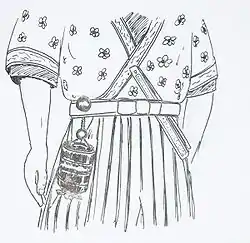提げ物
Japanese

提げ物: sagemono hanging from an obi, with a netsuke keeping the end of the cord in place
| Kanji in this term | |
|---|---|
| 提 | 物 |
| さ Grade: 5 | もの Grade: 3 |
| kun’yomi | |
Alternative forms
- 提物
Etymology
Compound of 提げ (sage, “hanging”, the 連用形 (ren'yōkei, “stem or continuative form”) of verb 提げる sageru “to hang something”) + 物 (mono, “thing”).[1]
Pronunciation
- Kun’yomi
- (Tokyo) さげもの [sàgéꜜmònò] (Nakadaka – [2])[2][3]
- (Tokyo) さげもの [sàgémóꜜnò] (Nakadaka – [3])[2][3]
- IPA(key): [sa̠ɡe̞mo̞no̞]
Noun
提げ物 (hiragana さげもの, rōmaji sagemono)
- a carrying container hung from the waist, such as a coin purse, tobacco pouch, or pillbox; a netsuke would be attached to the end of the sagemono cord to keep the cord from slipping through the wearer's 帯 (obi, “belt”)
See also
- 巾着 (kinchaku): a traditional Japanese drawstring bag or pouch.
References
- 1988, 国語大辞典(新装版) (Kokugo Dai Jiten, Revised Edition) (in Japanese), Tōkyō: Shogakukan
- 2006, 大辞林 (Daijirin), Third Edition (in Japanese), Tōkyō: Sanseidō, →ISBN
- 1998, NHK日本語発音アクセント辞典 (NHK Japanese Pronunciation Accent Dictionary) (in Japanese), Tōkyō: NHK, →ISBN